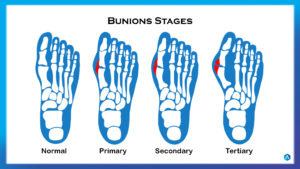Bunions
- Edgard Diaz
- December 23, 2019

Bunions form on the joints of the big toes. They may only present on one foot but when they develop they push against the next toe and push the big toe on an angle, often causing the skin to become inflamed. Severity varies from person to person.
There are three stages of bunion – primary, secondary and tertiary as per the diagram above.
Primary stage mostly occurs in adolescents, where the parent sees their child developing a deformity of the big toe and a lump forming.
Secondary stage appears between approximately 25-55 years of age, and this is usually a progression of the primary stage as biomechanical anomalies have not been treated or addressed. If treated at the primary stage this may prevent or slow down the progression of the bunion forming, but it is not a cure.
Tertiary stage occurs when biomechanical anomalies are not treated. This usually occurs in the over 55s. If there is not much pain, conservative treatment is advisable, but if pain is making life very uncomfortable then surgery may be required with referral to a surgeon. Orthotic treatment may also be advised to prevent the condition from getting worse, as the biomechanics need to be addressed. These will assist in aligning the foot and transferring the weight off the big toe.
Bunions are hereditary in nature as the first metatarsal bone is born shorter than the second, causing the first bone to lean inwards to get ground contact and then with gait the big toe is forced inwards by the ground reaction force applied with every step. Hence the progression of alignment of the big toe.
Symptoms
There are a few signs to indicate a bunion is developing:
- Regular or intermittent pain at the base of the big toe
- Regular inflammation around the big toe joint
- A change in the position of the big toe and the forming of a bump on the inside of the base of the big toe.
- Other toes crossing over and restricted movement of the big toe
- Formation of corns or callouses on other toes caused by the movement of the big toe.
Assessment
A biomechanical assessment, particularly using Dr. Abbie Clinics’ unique NBA (Najjarine Biomechanical Assessment) system, can quickly determine imbalance and foot problems such as bunions that could be affecting a patient’s gait, posture and wellbeing. Further confirmations would be done via X-ray or MRI if required and if severe referral to a podiatric or orthopaedic surgeon.
Treatment
Depending on the severity of the bunion, treatment can be non-surgical and conservative simply to relieve pain and bunion pressure otherwise surgery and referral to a surgeon will be required.
Non-surgical approaches include:
- Ensuring shoes are comfortable and spacious so toes are not constricted.
- Strapping, padding or splinting.
- Anti-inflammatory medication
- Icing to reduce inflammation when this occurs
- A brace may assist with pain but does not correct the bunion
- Exercise can also assist with pain but does not correct the bunion
- Prolotherapy treatment can assist in ligament and joint repair, shown to be affective with orthotic devices
- Orthotics to take pressure off the affected area.
If you are experiencing these symptoms call 1800 DR ABBIE or email reception@dr-abbie.com to organise an assessment.
Source: Mayo Clinic website and Dr Abbie Najjarine’s experience


